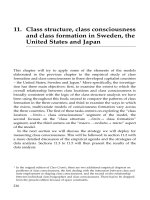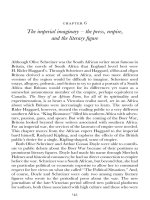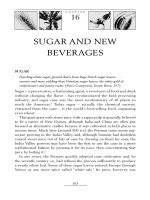THE COLUMBIAN EXCHANGE AND NEW WORLDS
Bạn đang xem bản rút gọn của tài liệu. Xem và tải ngay bản đầy đủ của tài liệu tại đây (190.84 KB, 13 trang )
150
CHAPTER
15
THE COLUMBIAN
EXCHANGE AND
NEW WORLDS
Why, then, the world’s mine oyster, Which I with sword will open.
Shakespeare (1564–1615)
1
OCEANIA
In the south of Southeast Asia, Alocasia or dryland taro, perhaps originating
in India or Burma, has been under cultivation for at least 7,000 years. Wetland
(Colocasia) taro, yams, and (probably) dry and wet land rice came along
later. Yet, as mentioned earlier, a mystery is why the Austronesian farmer-
pioneers, who sailed off to settle the Philippines and the East Indies at about
this time (6000
BCE
), were accompanied by taro, yams, pigs, and dogs, but
not rice. The most logical answer is that rice had not yet become a staple
in Southeast Asia. But it is not a particularly satisfactory answer because,
despite many ensuing waves of Pacifi c pioneers, when the Europeans fi rst
entered the world’s largest body of water, rice was absent from the whole of
the Pacifi c, save for the Mariana Islands. Did rice somehow get lost from the
horticultural complex? Or were taro and yams just easier to cultivate?
2
The pioneers originated in Southeast Asia and neighboring New Guinea,
and their initial waves fanned out into the Philippines and the East Indies.
These were an Austronesian-speaking people whose descendents, with
their distinctive Lapita pottery, became the ancestors of the Polynesians.
The Columbian Exchange and New Worlds
151
Around 3,500 years ago they launched epic voyages of exploration and
colonization, moving swiftly in their double-hulled canoes to establish
settlements in Fiji, and then in Samoa and Tonga – the latter two islands
becoming jump-off points for the eventual settlement of the rest of
Polynesia, ending with Hawaii around 1,500 years ago and New Zealand
some 1,000 to 2,000 years ago.
3
These seafarers were fi shermen to be sure, but also farmers, whose con-
tribution to Pacifi c comestibles was as impressive as their navigation skills.
They added pigs, dogs, and chickens to a region short on edible land ani-
mals, along with plant foods like taro and yams, and food producing tech-
niques like sago palm cultivation (starch is extracted from the trunks).
4
Also introduced were domesticated coconuts, invaluable for their milk;
meat, and oil;
5
bananas and plantains that became a staple for many;
6
along with breadfruit and sugarcane, all of which spread widely through-
out the Pacifi c.
7
Yet, incredibly, these pioneering peoples were actually latecomers
when compared with their Australoid predecessors, who long before had
taken advantage of lowered sea levels to walk and fl oat across the straits
to New Guinea (or Sumatra and Java) and then on to Australia where,
around 50,000 years ago, they struggled ashore to enter a hunter-gatherer’s
heaven.
8
In addition to a plethora of wild plants, there was an abundance
of large animals, including giant marsupials and fl ightless birds on hand for
the taking.
9
Because Australia and New Zealand had been cut off from the rest
of the world for close to 100 million years, the evolutionary process was
given free rein to elaborate plants and animals that were decidedly differ-
ent from those found on the Eurasian land mass.
10
Australian kangaroos,
for example, are browsers. But as marsupials they bear little resemblance
to European cattle or North American bison, browsers also, but placental
animals. In New Zealand, penguins roosted in trees and sea lions stretched
out for a nap in forest clearings. And its huge ostrich-like moa birds, some
around nine feet in height, were unique.
11
But they, along with many other
fl ightless birds, are extinct now, victims like so many other species the
world over, of hungry humans.
Plants that became staples for the Australian Aborigines had also taken a
different evolutionary path, despite apparently familiar English names for
“bush tucker” such as “sunrise lime,” “bush tomato,” “bush banana,” “bush
bean,” and “Australian carrot.” Desert Aborigines received an estimated
152
A Movable Feast
70 to 80 percent of their dietary bulk from plants such as these, and in the
humid southeast, approximately 140 species of plants were eaten – fore-
most among them the roots and tubers of lilies, orchids, native yams, and a
variety of fruits and seeds.
12
In New Zealand, bees buzzed, making honey from the fl owers of the
Manuka tree that was employed by the Maori as a medicine as well as a
food.
13
The Maori consumed much bird fl esh starting earlier on with that
of the moa and working their way through penguins, ducks, and a variety
of “bush birds” – pigeons, various gulls, albatross, and the like. They also ate
substantial amounts of fi sh and shellfi sh, as well as human fl esh from time
to time, although the latter was apparently a ritual form of cannibalism
reserved for those killed or captured in war.
14
Over the span of millions of years, watertight, buoyant seeds had fl oated
from Southeast Asia to Australia and to other parts of the Pacifi c, or had
caught a ride in the plumage or bowels of birds. But it was only with the
arrival of humans that Oceania, and especially Australia and New Zealand,
experienced a genuine reunion with the biota of the larger world.
In returning to a mystery mentioned earlier, most Pacifi c peoples were
eating sweet potatoes when the Europeans fi rst encountered them, and,
according to their folklore, had done so for a very long time. But because
the tuber was an American plant, it obviously must have been introduced
at some juncture, and three different hypotheses attempt to shed some
light on how and when this occurred.
15
The fi rst, and most intriguing, of
these would have the sweet potato introduced to the Eastern Pacifi c some-
time between 400 and 800
AD
and diffusing from there – which, of course,
fi ts right into another riddle of Oceanic prehistory. How ancient was its
contact with South America?
One interesting tidbit of linguistic evidence is the Polynesian word for
sweet potato ( kumala or kumara), which is strikingly similar to the Que-
chua word for the tuber ( cumara) suggesting to some that the sweet potato
reached Polynesia from Peru, with Quechua speakers somehow implicated
in that transfer. But if so, why only the sweet potato? Why not other useful
Americans foods like white potatoes, manioc, or maize?
16
A second hypothesis would have the sweet potato, taken to the East by
the Portuguese in the sixteenth century, somehow fi nding its way into the
Pacifi c a couple of centuries before Captain James Cook arrived (during
the years 1768–71 and 1772–75) to report on its presence there. A third,
and more pedestrian, hypothesis has the Manila Galleon traffi c introducing
The Columbian Exchange and New Worlds
153
the sweet potato to the Pacifi c, where it spread so rapidly that it seemed
like a long-established foodstuff to the members of the Cook expeditions.
Still another possibility is that, although sweet potatoes cannot fl oat,
their seeds could have hitched a ride in the bowels of birds such as the
golden plover – a strong fl yer that ranges over Polynesia, but visits western
South America now and again. Clearly, when and how the sweet potato
reached Oceania are still open questions. But what is not disputed is that
whenever the tuber made a Pacifi c appearance, it readily fi t into the diets
of the peoples of that vast region.
17
There were no pigs in Australia and New Zealand before the Europeans
brought them. Chickens they had, along with the “dingo” of Australia, a
descendent of the Asian wolf that must have accompanied a later wave of
settlers from Southeast Asia because it had to be domesticated fi rst. Cook
introduced pigs to New Zealand in 1778 and the wild ones are still called
“Cookers.”
18
Pork was much esteemed by the Maori and added some vari-
ety to diets whose animal protein had previously been provided by birds
and only two four-legged animals – the dog and the rat. In Australia pigs
came ashore with the British colonizers and, with no natural enemies, pro-
liferated to the point where in the twentieth century the Australians went
to war with their wild pig population.
Less troublesome were Merino sheep, introduced in 1833, to add meat
to the diet and wool to the economy. Today, pastoralism has produced
the world’s largest sheep population in Australia and one of the highest
human-to-sheep ratios in New Zealand. Cattle fl ourished about as well as
pigs in the absence of predation. Two bulls and six cows arrived with the
First Fleet in 1788 to become the progenitors of the millions of cattle that,
in the nineteenth century, were fi rst a nuisance and then, along with mut-
ton, the foundation of Australia’s meatpacking industry.
19
These grazing animal legions opened the door for opportunistic Euro-
pean weeds such as white clover, and with the introduction of the honey-
bee to pollinate the clover, Old World animals were once more munching
on an Old World favorite. It is not surprising that both Australia and New
Zealand became nations of meat eaters. It was a matter of self-defense.
As for plant foods, white potatoes carried by the colonizers were promptly
utilized by the Aborigines in part, at least, because they were easier to
grow than sweet potatoes. Maize was the fi rst cereal to gain acceptance
in Australia and New Zealand. Wheat only became widespread around
the middle of the nineteenth century, as did European and American
154
A Movable Feast
vegetables, Eurasian fruit trees, and grapevines. Winemaking was fi rst tried
in Australia in the late eighteenth century, the vines brought from Europe
and from South Africa where winemaking was already established. The
earliest vineyard in New Zealand was planted shortly before 1820.
As one might expect, long geographic isolation triggered the occasional
ecological nightmare as new fauna reached both Australia and New Zealand.
The brown rats from Europe that jumped ship in New Zealand all but exter-
minated their local counterparts and grew to enormous sizes – which, at
least, provided more good quality protein for the Maori. In Australia, a few
rabbits were imported in 1859 by a farmer to provide a little sport for hunters.
He was apparently ignorant of the rabbit’s spectacular reproductive capacity
(females can deliver up to eleven litters each year) in the absence of natural
enemies and got far more sport than he had bargained for.
20
In fact, that sport soon became a grim, but fruitless, campaign of exter-
mination as the Adam and Eve rabbits multiplied into an estimated 20 mil-
lion within 30 years, and hordes of them spread across the continent to
compete with livestock for grazing land.
21
The rabbits did provide food for
the lower classes, however, and in the 1880s rabbit meat was being canned
in Australia, and hundreds of tons were exported. More recently, Austra-
lian possums have invaded New Zealand to destroy forests and spread
tuberculosis among its cattle. Fortunately, most other Pacifi c peoples were
spared this sort of ecological excitement and, despite missionary meddling,
their diets remained more or less traditional until the middle of the next
century.
Aside from offi cers and cabin passengers, the fi rst settlers to wobble
down gangplanks in Australia were convicts sentenced to “transportation,”
along with their guards – hardly representatives of British Isles elites.
22
Aboard ship their “rations” had centered on salted meat and bread, and
such “prison food” continued to be issued ashore to the rural work force
until the fi rst half of the twentieth century. Called “Ten, Ten, Two, and a
Quarter” the weekly rations consisted of 10 pounds of fl our, ten of meat,
two of sugar, and a quarter pound of both tea and salt. Many who migrated
voluntarily after the 1830s were spared this “crew culture,” although not
those who began the settlement of New Zealand from Australia in the
1840s. The New Zealand Company also relied on such tried and true (not
to mention cheap) rations.
The success of pastoralism meant a surfeit of available meat, and quan-
tity not quality determined the success of a middle-class meal. But the









